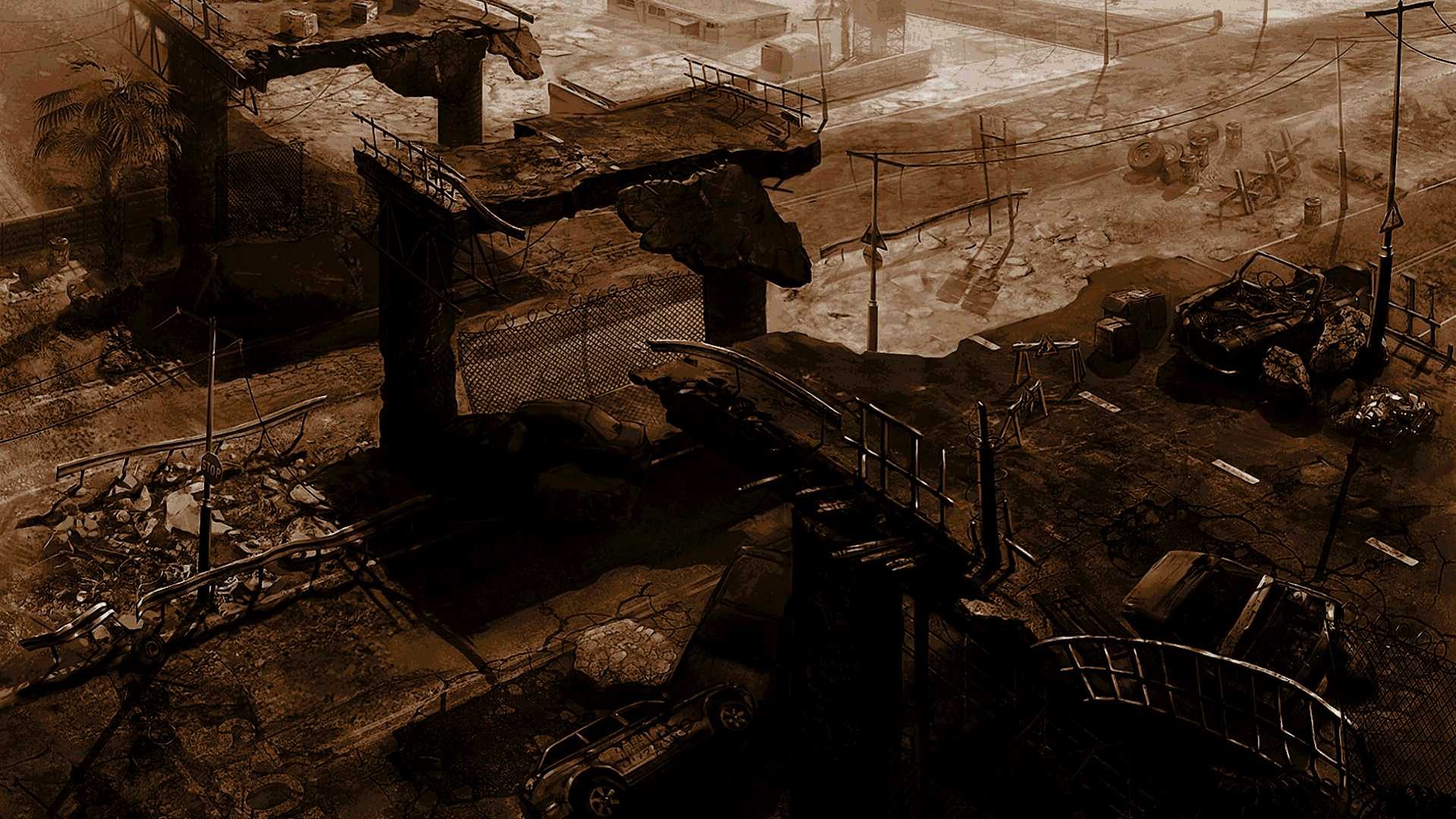Where we Started
We started this mess all in about 2015 on a drunken idea with friends in Doc’s garage. In fact, for the first 3 years, the garage was our recording studio. No acoustic treatments, it echoed badly, harleys running by without exhausts, neighbors mowing lawns, dogs barking, people walking in on us. It was great. But we had an advantage. Will and I are audio engineers. Both of us worked in and on audio professionally for years. I designed and installed and tuned large venues and recording studios. Will had extensive experience in the live stage music environment. Together, we figured we could pull this off at a level that other live play podcasts could not do. Have high-end audio and make it like an audio drama. We started before any of the big budget production today, even thought of doing their podcast with hired actors and audio engineers. So we cobbled together and started on season 1.
We actually recorded mere feet from the renown Ice Pick’s stage. In the heyday of Punk Rock and CBGB, there was a small dive bar that was the Midwest center of punk rock called the Ice Pick. Punk Rock legends played there regularly and the results were even more legendary.
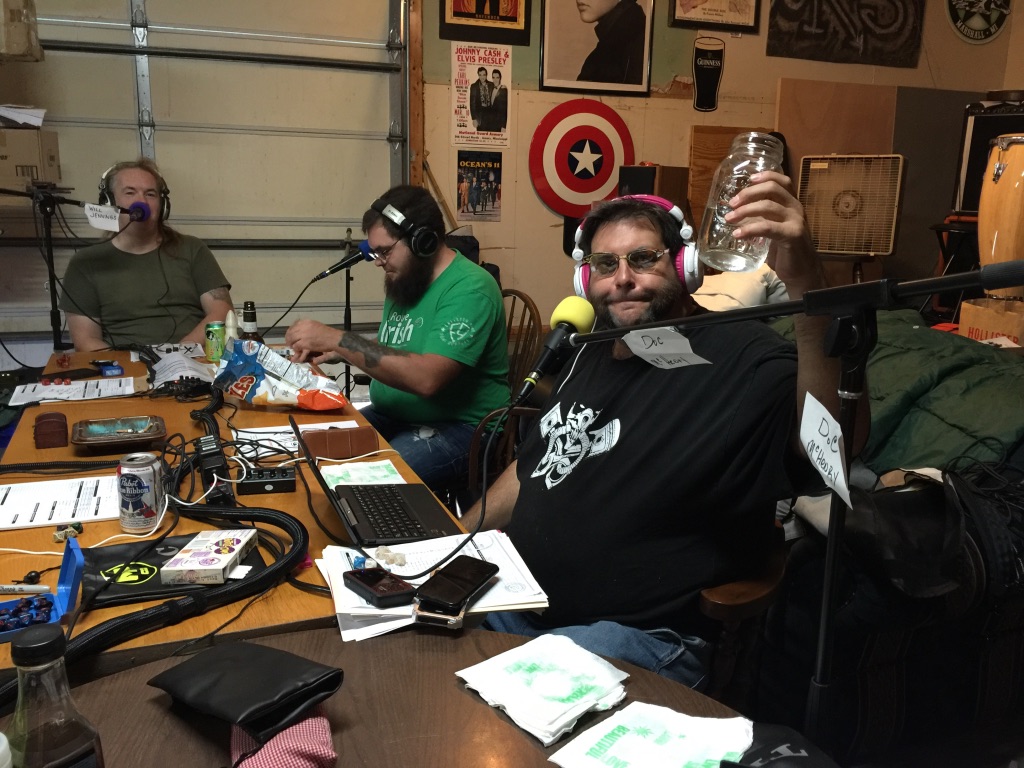
We started with cheap cables, cheap knockoff SM58’s and everything that was as low cost as possible. We recorded the entire first 12 episodes on basic junk gear. Those mics in the photo above cost $5.00 each off of amazon and are still our spare mics. in case any of the Shure SM58’s get damaged. The cables were the cheapest possible and used, a junk china headphone amp in the middle of the table and $14.00 Tascam lowest end headphones. Doc rocking the bright pink set we got for $8.00
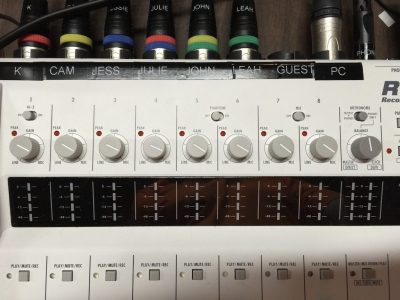
All we had was a dream and an old zoom recorder that Tim had.
Will when asked how we got started
Things changed and life changed. Tim had to move to Florida for work, so the team upgraded from the early zoom recorder to something more suitable. the voices on the podcast were growing. that guest input was full shortly and then shared by the newly added RJ to the team. At the peak we had 9 voices including Tim/Guy. We had to upgrade. And upgrade so that the Michigan studio and Florida studio could be identical.
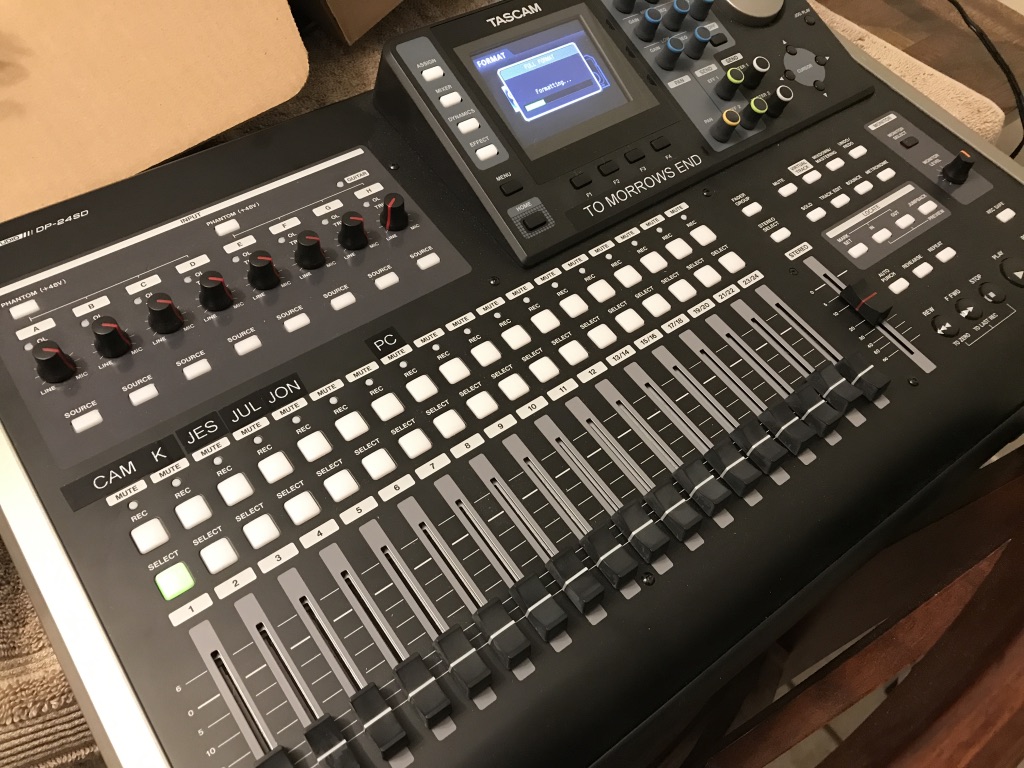
Holy crap Tim, we are not made of money!
Doc upon learning Tim just bought two new recording consoles
Having duplicate equipment meant that tech support from Florida can easily assist the studio members up in Michigan easily. Also, some acoustic traps were built for the Michigan studio out of home depot’s cheapest closet doors and cheap carpet to keep the neighbors lawnmower out of the microphones and the street noise as we were close to a garage door that let in all the noise. Audio quality went up significantly as the more profession gear allowed a lot of options. Better microphones were tried, but we discovered that the best sounding of everything were good old-fashioned Shure SM58 microphones. They are designed for stage use and untreated rooms with reflections and noise. In a untreated space, they do better than a $10,000 microphone. I really hate hearing someone recommend an expensive microphone to a podcaster. They will not like that expensive mic because they do not have an acoustically treated room. So our first tip. Ignore anyone that tells you that you need a fancy microphone XXXX. They do not know what they are talking about. Yes I just called out 95% of all the “pro podcasters” as not knowing what theyare doing. Get a cheap SM58 clone if you can not afford a real one, and get your mouth on it. Yes ON it. About 1 inch away and adjust for that. This will get rid of a huge amount of room noise and make you sound fantastic.
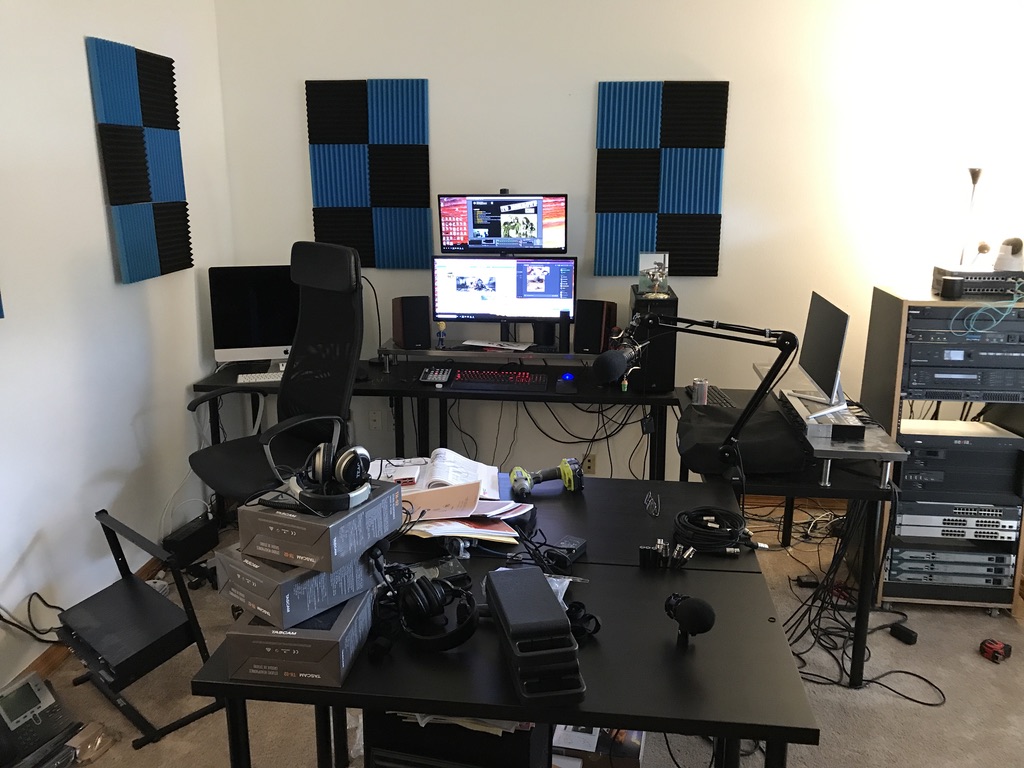
The Florida Studio
In the beginning, the Florida studio was cobbled together. it had a dual use, record Tim’s voice and produce the podcast remotely. But the room was an echo chamber and some ideas were already brewing about expanding to have a second team. Go from monthly to bi weekly and have a completely separate team wake up and start their adventures in the south. So the Florida studio had to be designed and created. And on a budget because once again, audio gear is expensive!
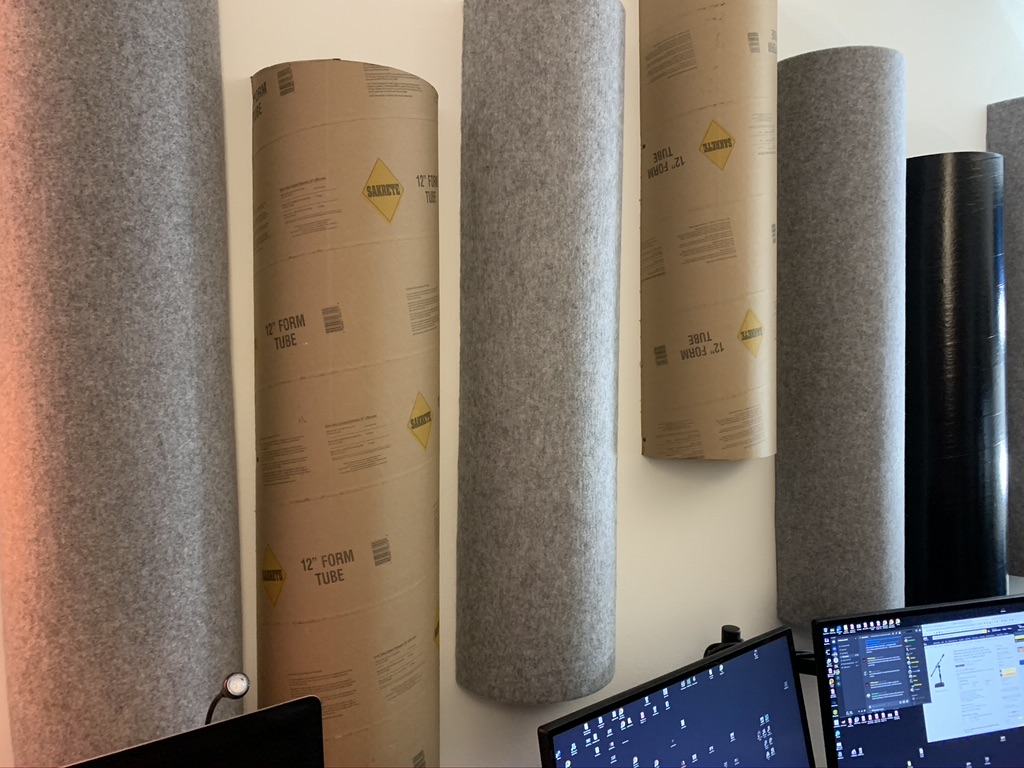
Acoustic treatments do not have to be expensive. one of the easiest is to buy “sonotube” concrete form tubes from home depot, cut them in half, staple sticks in back to keep them in a half curve and glue carpet to them or paint them. These act as diffusers and will break up reflections making a space sound a lot better.
So the process began to build the Florida studio. Tim built a lot of it from scratch. Audio treatments on the walls were as simple as shipping blankets on the walls. in the photo below was from the first days of the Recon 17 recording sessions. Trying like heck to get sound under control as the room is small and reverberated badly. sound from one side of the table would reflect off the wall and into the other persons mic. To fix it right away the blankets worked and were plentiful from the move. But then the Diffusers were built out of sonotube and worked for quite a while. The room was not dead but it did not have reflections and sounded good. Scoring a used Ikea conference table for nothing other than ” come and get it out of my garage” was perfect as well. we had room to fit 4 in the Florida studio, and using really cheap mic arms we started recording Recon 17.
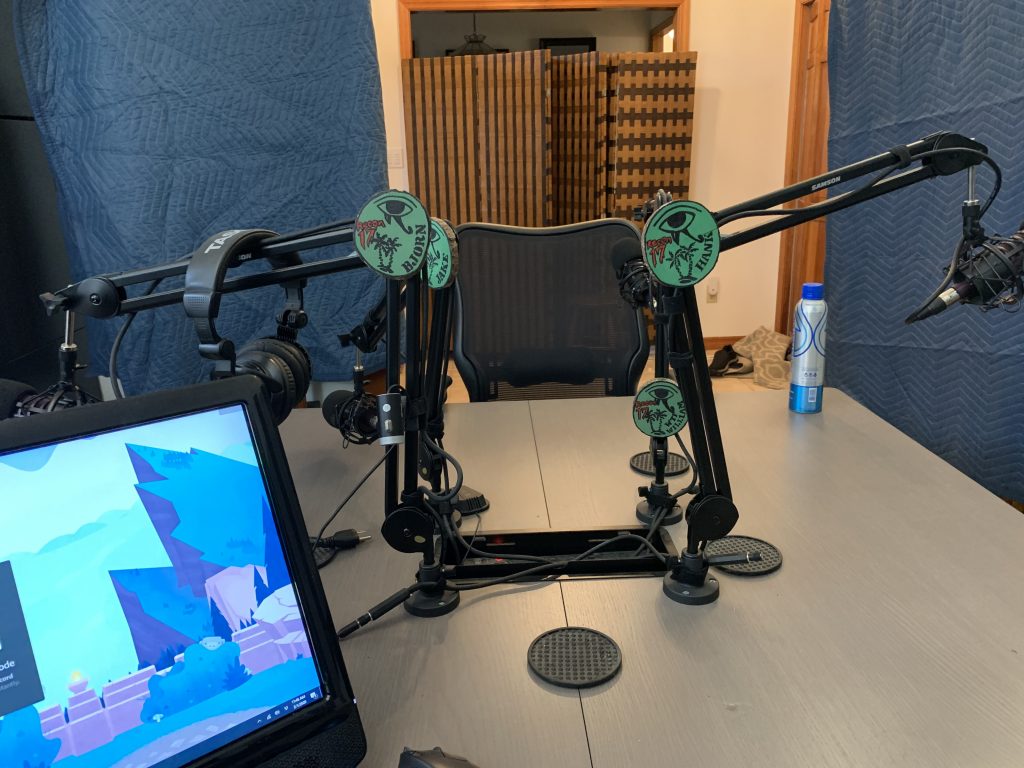
Just get something up on the wall to suck up sound or break it up. Something, Anything is better than nothing
Bob McLaughlin – Sound Engineer that designed the Van Andel Arena’s audio
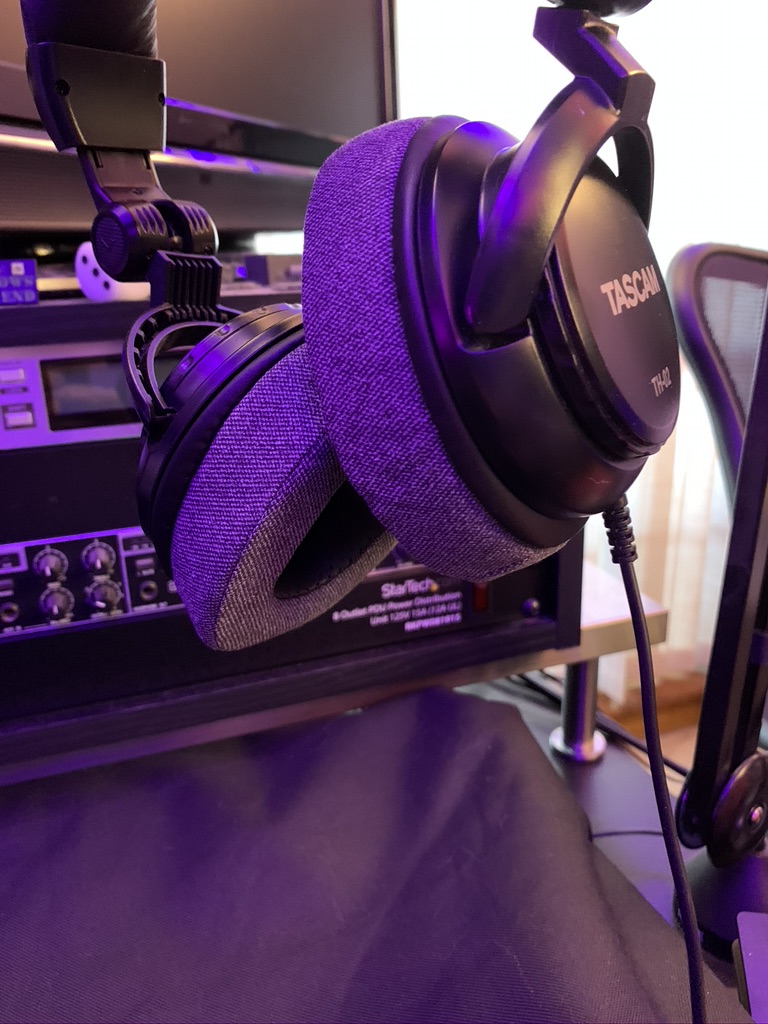
Cheap Headphones can be upgraded.
We still use the junk TASCAM headphones in the south. I upgraded mine with some nicer ear cups as the stock ones if you sweat suction cup to your head and really suck when you pull them off quickly. These cloth cups were not made for these headphones, they are gamer memory foam covers that were also inexpensive. They are funky to get on but fit well and work great. Honestly, are they good enough for listening to 192Kbps Artisan Handcrafted FLAC multi-track audio recorded at the perfect humidity and temperature? No. But they are fantastic for any podcasting. they work really well for the human voice and if you break them, like we have done on several sets, they are cheap to replace… You do not need high end studio open back headphones like some “podcasters” claim that you need. But I do recommend over the ear types like these. Earbuds just do not cut it unless you are using IEM’s (In Ear Monitors). and those you can also find for affordable prices out there.
So the process today is the team records, and I record my end while we talk to each other using the internet. We started with Skype, that sucked. Then we tried Discord and while that worked, the audio quality was low and discord really has junky echo cancelling so there were a lot of echos. This did not affect the recordings because both ends record locally to a dedicated recorder. We are currently using the TASCAM DP-32SD at each end. Using the effects bus to set up a mix minus to send only the microphones to a USB sound interface to the PC while not sending the audio coming back from the other end back to them. This eliminates echo loops, but if someone’s headphones are loud enough and they are on top of the microphone like they are supposed to, we can still get echo or worse, someone sets the headphones on the mic while they step away. Today we use Mumble and our own server hosted on this server right here. it means we have control and I can set the audio quality ourselves. Discord would work if we paid for server boosts, but the echo cancelling problem with discord still remains. We “broadcast” on discord by my recording board, taking the final mix of this end and sending it to the voice channel.
During the pandemic, I made some contacts at a few places and the number of listeners exploded. Because of this, the number of supporting listeners grew that wanted us to keep doing what we have been doing, throwing financial help at us. This manifested in upgrades. 100% of supporter funds go directly into the podcast. Well, I lie… it’s like 140%. I still pump cash into it monthly. I just now have help from listeners.
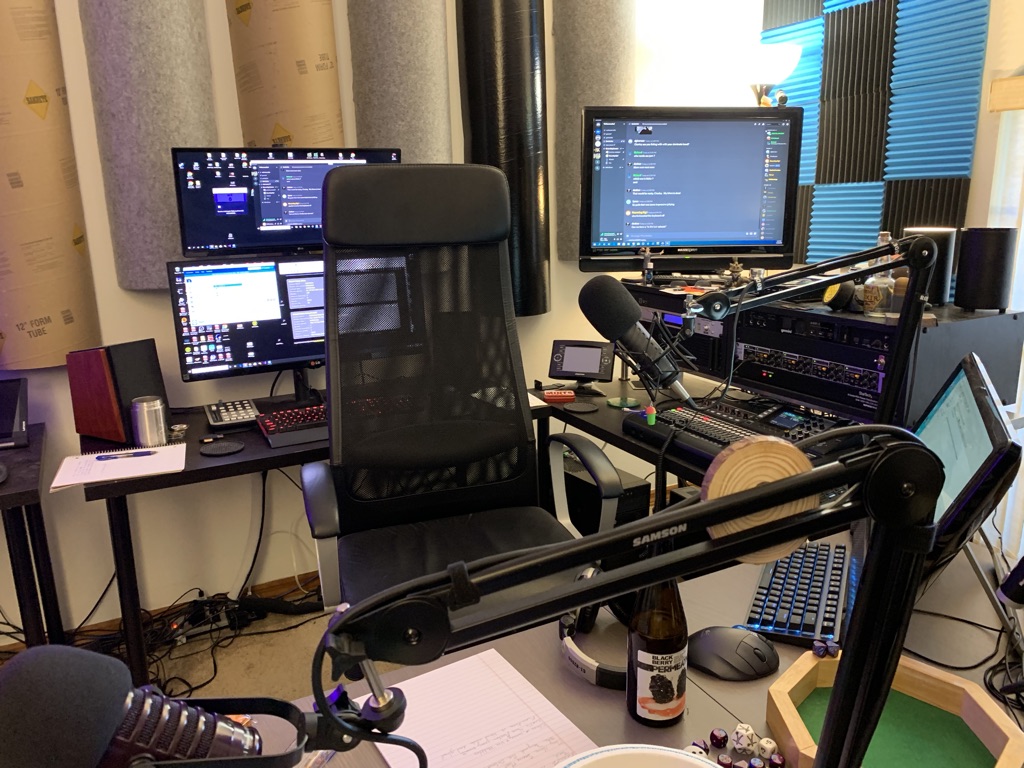
My microphone is a Rode Procaster. Yes it’s Nice. No I dont need it.
Tim
A best friend of mine that started the largest Star Wars Edge of the Empire live play podcast, sent me that microphone and stand as a supporting listener. The TV in the background that the Recon 17 players can view Discord shenanigans in the fanchatter channel was donated by a listener as well. It also shows any map detail they need to see along with the supporting listeners in the discord channel when we live broadcast. In front of me is two really really old Dell monitors that I use for information displays that I dug out of the trash at work.. The players in Florida for Recon 17 do not use SM58 mics. They use a set of mics that were donated by MXL to us and they are the MXL BCD-1 microphones. and honestly I am thinking of going back to SM58’s. They do not have rear rejection like the SM58 so there is more audio bleed. They sound nice but they are NOT for radio or podcasting. And at their price, they are not worth it at all. Their “shock mount” does not work, it’s just foam. and their mounting system is horrible. I had to find the fat mic spider clamps to get the table noise out of them. When I first mounted them, you could hear everything that touched the table, it was horrible. Good old SM58’s in cheap rubber band shock mounts worked massively better. I still have them. I may go back to the old setup. Some podcasters tell you “Shure SM7B!!!!” it’s all for looks. the SM7B is a SM58 in a special shell for $400… a clone SM58 in a $15 rubber band shock mount will sound as good for 1/10th the price. You just wont look “uber leet” on video with it.
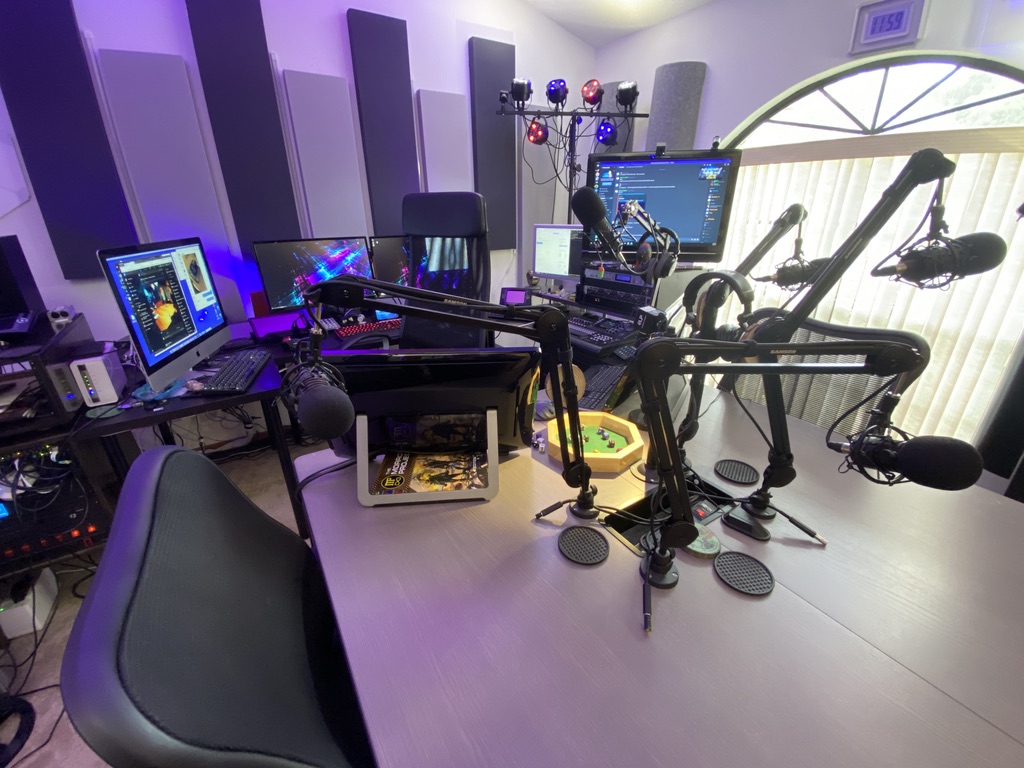
Today’s Setup
Fast Forward to today. Room treatments upgraded, I needed full deadening and adsorption because of noisy neighbors and living on a road where thumping bass for everyone to hear is required for every car. The panels are 2 inches thick filled with a hard board sound insulation and covered in fabric. They are from a company in Tampa called AcoustiMac and they did not donate them, but gave me a hell of a deal for them. I paid cash and have both main walls covered in them. I have the sonotube diffusers on the shorter walls and up high as well and when you walk into that room, it’s noticeably quieter. To where, if the doors are open, you can clearly hear the reverb from the entryway. And yes, I have some DMX stage lights. They are cheapie china junk $15 each. They add some color and are more for me to play with in my day job of a lighting and automation programmer. I spent no listener funds on those.
Sound editing. I use Reaper. hands down it destroys all other multi-track DAW software out there. I have used ProTools, I own Logic Pro, Reason, all the DAW’s out there really can not touch Reaper in value or abilities. Download it and play around, it will run forever in demo mode. Moving to the future, we are adding more. The company I worked for donated some stupid expensive DSP hardware that I have in place here in Florida and will ship to the Michigan studio this year to completely eliminate any echo in the live streams from our two endpoints. The other challenges are the remote players. Doc is in Seattle, Jake from R-17 is in Missouri, and Leah is in California. getting their audio recorded is a challenge. Doc upgraded to a Zoom 4 channel recorder Podtrak P4 recently as Ashcan now lives out there as well. That means the Garage is no more the North record studio. The new Michigan recording studio is actually in Charley’s Home, another acoustic nightmare. but we are going to upgrade it to have sound panels and more. The other remote players are using a Berenger UM2 with a Shure mic and cheap headphones. Because they work fantastic for getting rid of untreated room noise. Jake from R17 got his just at the end of last year and we have not made it to the good audio yet in the backlog of the recordings.
That is really it for now. I will update more as we expand and change our gear as I am ever chasing better audio and trying to make it a Lot easier for everyone on the teams.
